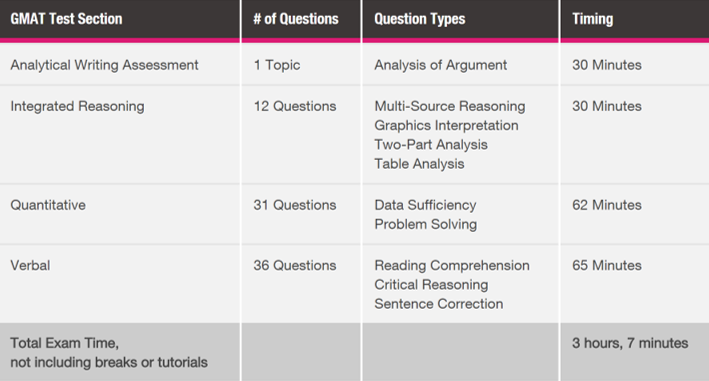
You graduated from college with a bachelor’s degree in a specific business practice. Accepted a role with a company that presented exciting new challenges and endless growth opportunities. Four years later you find yourself plateauing and in a similar situation you were in when approaching college graduation. What’s next? How can I continue to grow? Am I on a path to lead me to my ultimate goals?
I myself was, and still am, interested in growing as a leader and expanding my network of passionate and goal-oriented individuals. After exploring my options it became glaringly obvious that I wanted to continue my education with an MBA program. And, while that comes with many challenges such as which colleges you want to apply for, online/vs. in-person, local or overseas; the first hurdle is the Graduate Management Admission Test (GMAT). I am writing this article to lay out how I prepared for the GMAT and achieved the score necessary to get accepted into the program of my choice.
Let’s start with the basics:
What is the GMAT?
The Graduate Management Admission Test (GMAT) is exactly what it sounds like, a test that grants you admission to a Masters of Business Administration program. While it is a standardized test, what separates the GMAT from the pack is that it is computer adaptive and focuses on understanding your critical thinking skills in a time-sensitive setting. All that means is that the test increases or decreases difficulty depending on how well you are doing.
The test is broken down into four sections: Analytical Writing, Quantitative, Verbal, & Integrated Reasoning.
While you have to take the Analytical Writing and Integrated Reasoning sections, I would dedicate 80-90% of your time studying the Quantitative and Verbal sections as they are the major focus for Universities and make up your overall score.
The Analytical Writing Assessment tests your ability to analyze arguments by finding assumptions and unsubstantiated premises the prompt question relies on.
The Quantitative section challenges you to think conceptually about how to solve a problem as opposed to the traditional formula-based mathematics you are used too. The Data Sufficiency questions are the most jarring as it asks you to decipher whether the problem can be solved with the information given and not what the actual answer is.
The Verbal section tests reading comprehension, the ability to think critically about what each sentence means, and your general knowledge of grammar and diction.
The Integrated Reasoning section is a newer addition to the test that combines both quantitative and verbal skill sets. They generally give you some data or text and ask you to answer a group of questions that you can solve from the info provided. These should seem more relatable if you have been in the workforce for a bit.
Here is the GMAT Exam Format as provided from mba.com:
How does the scoring work?
As I mentioned before, your Verbal and Quantitative make up your total GMAT score which ranges from 200 to 800. MBA.com states that two-thirds of test takers score between 400 and 600.
Verbal and Quantitative scores range from 0 to 60, while scores below 9 and above 44 for the Verbal section and below 7 and above 50 for the Quantitative section are hard to come by.
The Analytical Writing Assessment ranges from 0 to 6 in half-point intervals. It is scored independently twice and then averaged to make up your final score.
Integrated Reasoning scores range from 1 to 8 and there is no partial credit given. Most questions range from 3-5 responses and all responses must be correct in order to receive credit.
What resources are available to help me study?
This is a tricky question as there are unlimited resources out there and they depend on your budget, time, and individual study habits. Truth be told, I tried to study last year with little direction and eventually fizzled out. I came back out this year knowing I needed to change something.
I put money down and bet on myself. I scheduled the test ($250) out 3 months and joined an organization called Prepcorps ($1,000) which forced me to dedicate weekly time with others that had the same goal. I scheduled time with one of the tutors at Prepcorps outside of our regular time to dive deep into my weaknesses.
For the class, we were required to buy the GMAT Official Guide 2018 ($25) and sign up for a website called Magoosh ($200). When you purchase the book and schedule your GMAT you are given a few practice tests that will come in handy. You will get to the tests eventually, but I started my studying by familiarizing myself with concepts utilizing the videos, quizzes, and practice questions on Magoosh. They provide helpful walk-throughs of every question, blog posts that dive further into each issue and have a lengthy catalog of videos that re-introduce you to verbal and quantitative topics.
The key to succeeding in this test is learning from your failures. If you get an answer wrong, always read the explanation and make sure you understand it. Then proceed to try similar questions until you master them. Write the principles down on note cards and quiz yourself whenever you have time.
The last resource I found most important was mental toughness. You will need to get really good at saying no to friends and fun. I know, sounds horrible right? But continuous growth and practice are key to accomplishing your GMAT goals. Prioritize and create a study game plan so you can persevere!
How long should I study for the GMAT?
Before all else, take a diagnostic/practice test and find out where you stand. It will feel weird, but it is the only way to determine what you need to work on. I scored lower than my target and the school I wanted to attend’s average, so I determined that 2-3 months should work. Here is a sample of the 3-month study plan I put in place:
Month 1:
– Learn about the GMAT format and structure & take a diagnostic practice test
– Review your weaknesses and start reviewing general Quantitative & Verbal format and question types.
– End the month with a practice test. Review your practice test results and read answer explanations for questions you got wrong or had to guess on. Create a focused study plan to strengthen those weaknesses.
Month 2:
– Focus on advanced Quantitative & Verbal review, dedicating at least 20 hours a week to practice questions. Make sure you are timing yourself per question to ensure you don’t waste your time come test day.
– Take a second practice test and see where you improved or regressed. Look at answer explanations and create a study plan accordingly.
– Start reviewing the Analytical Writing assessment and Integrated Reasoning strategies. Look at the examples of well-written essays in the back GMAT Official Guide and what constitutes a good score.
Month 3:
– Continue with about 20 hours a week on practice questions by revising question types you got wrong in the past.
– Develop a keen timing strategy to help inform you to move on from difficult questions, as guessing doesn’t impact your score, but unfinished questions do.
– Take a final computerized practice test (preferably the one you got from GMAT) and review answers.
– Review all sections, question types, and fundamental concepts.
– Get a solid meal and a good night’s rest the night before the test and make sure you have everything organized for the exam (Where you need to go, water & snacks, test confirmation documents, etc.)
What score should I aim for?
This relies heavily on which program you are applying for and your personal test-taking abilities. My original goal was 680 and my top choice program average was a 608. My hard work paid off and I was accepted into the MBA Program of my choice!
Check out some of the top MBA programs and their average GMAT scores here.
Don’t be too discouraged, these are only average scores and there are other aspects that are taken into consideration when deciding acceptance.
If you don’t perform as expected, you can take the test again at a cost. I had my exam date 5 days before the deadline to apply for my program and put a lot of added pressure on myself which I wouldn’t recommend to any of my readers. You get your scores instantly and can send them to your top college’s right at the test center.
Long story short, the GMAT is a lot of work, but it is a test anyone can do well at with enough effort. Although this is a lot of information, I definitely left a lot out as well. Please reach out with questions or inquiries on things I may have left out by commenting below.
As always stay casual until next Tuesday!
EVB





No Comments